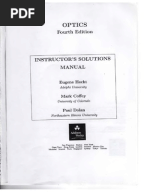
Eugene Hecht Physics Pdf Articles
Accurate, comprehensive and precise, this revision provides students with the most up-to-date coverage of optics. Responsive to students' needs, the focus of the revision was to fine-tune the pedagogy, modernize the discourse, and update the content. This book continues the gradually modernizing treatment of the previous edition by imparting an appreciation of the central role of atomic.
Eugene Hecht (born 2 December 1938 in New York City) is an American physicist and author of a standard work in optics.
Hecht studied at New York University (B.S. 1960) and Rutgers University (M. Sc. 1963). During his graduate study he worked at Radio Corporation of America.Adelphi University hired Hecht to teach and he became professor in 1978.
Hecht challenged the notion of potential energy in 2003.[1] The elusive nature of a universal definition of energy was argued by Hecht in a letter to the editor of The Physics Teacher in 2004.[2] Then in 2006 he wrote 'There is no really good definition of mass'.[3] He continued with the topic in 2011[4] and 2016.[5].
Kalavari kodalu songs download. Download Matti Gajulu Gemini Serial Title Song Download Song Mp3. We don't upload Matti Gajulu Gemini Serial Title Song Download, We just retail information from other sources & hyperlink to them.When there is a damaged backlink we're not in control of it. Each of the rights over the tunes would be the property of their respective owners.
Eugene Hecht is also widely published authority on George E. Ohr and American art pottery and a founding member of the American Ceramic Arts Society.
Books[edit]
His first textbook on optics was co-authored with Alfred Zajac, a colleague at Adelphi, in 1974[6]
In 1975 Hecht wrote the text Theory and Problems of Optics for Schaum's Outlines. In 1977 he began writing about polarization.[7] For the second edition of Optics in 1987 Hecht was the sole author.[8] A third edition was published in 1998, and the fourth in 2001.
Brooks/Cole published Physics:Calculus in 1996 in which reviewers 'found something intriguing on every page'.[9]
Celebrated potter[10]George Ohr was discovered after his workshop was consumed in fire.[11]
References[edit]
- ^E. Hecht (2003) 'An historico-critical account of potential energy: in PE really real ?', The Physics Teacher 41: 486 doi:10.1119/1.1625210
- ^E. Hecht (2004) 'Energy and Work', The Physics Teacher 42 L1 doi:10.1119/1.1787752
- ^E. Hecht (2006) 'There is no really good definition of mass', The Physics Teacher 44(1): 40–45 doi:10.1119/1.2150758
- ^E Hecht (2011) 'On defining mass, The Physics Teacher 49: 40 doi:10.1119/1.3527755
- ^E. Hecht (2016) 'On relativity, potential energy, and mass', European Journal of Physics 37(6) doi:10.1088/0143-0807/37/6/065804/meta
- ^Orestes Stavroudes (1975) 'Review: Optics by Hecht & Zajac', Physics Today 28(2):54 doi:10.1063/1.3068822
- ^E. Hecht (1977) 'Note on an operational definition of the Stokes parameters', American Journal of Physics 38(9):1156–8 doi:10.1119/1.1976574
- ^'Review: Optics, Second edition, Sky & Telescope July 1988
- ^Amy J. Kolan & Amy E. Larsen (1997) 'An introductory physics text that conveys the author's enthusiasm', Physics Today 50(4) 65 doi: 10.1063/1.881732
- ^Clark, Garth; Ellison, Robert A.; Hecht, Eugene (1989). The Mad Potter of Biloxi: The Art & Life of George E. Ohr. New York: Abbeville Press. ISBN978-0-89659-927-7.
- ^Hecht, Eugene (1994). After the Fire: George Ohr, an American genius. Lambertville, NJ: Arts and Crafts Quarterly Press. ISBN978-0-9637896-9-3.
- Eugene Hecht at Adelphi University
- Eugene Hecht at ResearchGate
Abstract
This paper is an exploration of the concept of energy, illuminated by the transformative insights of the special theory of relativity. Focusing on potential energy (PE), it will be shown that PE as presently defined is in conflict with the tenets of special relativity. Even though PE remains an indispensable theoretical device its actual physicality is questionable. Moreover its ontological status is quite different from that of both kinetic energy and mass, a significant point that is not widely appreciated. We will establish that PE is a theoretical concept as opposed to an empirical one; it is a descriptor of mass–energy without a detectable physical presence of its own. PE is a measure of energy stored, it is not the energy stored.
Export citation and abstract
Access this article
Login options

Individual loginorInstitutional login
via Athens/Shibboleth
The computer you are using is not registered by an institution with a subscription to this article. Please log in below. Find out more about journal subscriptions at your site.
Rent or Purchase this article online
Make a recommendation
To gain access to this content, please complete the Recommendation Form and we will follow up with your librarian or Institution on your behalf.
For corporate researchers we can also follow up directly with your R&D manager, or the information management contact at your company.
Institutional subscribers have access to the current volume, plus a 10-year back file (where available).